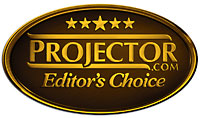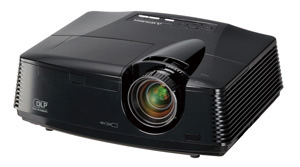 Go Back Go Back
 Print Page Print Page
Mitsubishi HC3800 Home Theater Video Projector Review
Review by Mike English

Verdict: BUY! Mitsubishi’s new HC3800 is possibly the best projector in it’s class. It features rich, vivid, lifelike colour, excellent contrast, and an incredibly accurate lens. It’s a little more involved to set up than a comparable LCD projector, but the trade off is a beautiful projector in a wonderfully small package.

By The Numbers:
Mitsubishi HC3800 – 1920x1080P, Texas Instruments DDP3021 DC4 DLP Chip (95% Aperture, Gamer friendly 0.016ms Response Time, RGB RGB Colour Wheel), 1300 ANSI Lumens, 4000:1 Advertised Contrast Ratio, 25dB (Eco-Mode), 5000 Hour
HC3800
| Pros |
Cons |
Small and lightweight making the HC3800 less intrusive to install |
Negligible lens shift resulting in more time consuming installation |
Black housing |
Slightly noisier than comparable 3LCD projectors, although at 25dB it’s still ¼ as loud as projectors from a few years ago. |
Startlingly good out of box picture quality |
Limited connectivity, although you should be using a good HT receiver anyway! |
Easy to use Menu system |
|
Backlit remote that activates by pressing any button |
|
Smooth film-like picture |
|
95% Aperture |
|
Sealed light path (no dust blobs!) |
|
Exceptional true Contrast Ratio |
|
Excellent presets |
|
Rich, vivid, life-like colour |
|
Six segment colour wheel means no rainbows |
|
Excellent optics |
|

The Mitsubishi HC3800 in it’s packing film to prevent scuffs and marks during shipping. You would take this off before use.
Overview
Mitsubishi’s goal in designing the HC3800 was to bring a new level of realism and performance to the sub $2000 category of home theater projectors. There’s been a lot of hype regarding the HC3800’s new BrilliantColor colour processing and 13 piece all glass Diamond lens assembly, and make no mistake, these are features you will see on-screen. The colours are rich and detailed with incredible subtlety. The HC3800’s black level is impressive, providing great depth and dimension to the image. Throw in a 5000 hour lamp life, RS-232 control, and six segment RGB RGB colour wheel, you have a projector proving that good things do in fact come in small packages.
Out of box performance was exceptional, with a clear, detailed picture with lots of pop, even in the mid-tone colours. Cinema mode provided the best dark room picture. The menu system is well laid out with lots of options for the tweaker, yet still easy to use for the novice. Calibration made a good thing even better, but is by no means required.
Set up
DLP projectors aren’t as easy to set up as LCD projectors, and the HC3800 is no exception. That said, the difference is marginal, and it’s something you’ll probably only do once. There’s no optical lens shift, so plan on installing your HC3800 with the lens approximately parallel to the top (or bottom) edge of the screen. This will vary with distance, but it’s a good rule of thumb. The throw ratio is a respectable 1.38-2.06:1, giving you plenty of wiggle room depending on your screen size.
Mitsubishi uses an attractive menu system on the HC3800. I found the menu to be well laid out, logical, with options where you’d expect them.
For purposes of this evaluation, I set the HC3800 on a table top about 14 feet away from a 119 inch Draper Hi-Def Grey tensioned electric screen. All calibration readings were taken “down the barrel” with the sensor facing the projector to eliminate any changes due to the screen. I propped the back of the HC3800 up a little, using an empty Blu-Ray case, to maintain geometry without resorting to keystone adjustments. Picture was provided by IMAX Super Speedway, Baraka, and BBC’s Planet Earth, all on Blu-Ray.
First Impressions
I wasn’t sure what to expect from the HC3800. It’s a DLP, admittedly a good one, and it’s small. I have gotten so used to the bloat on other units in this class that I had forgotten how small these HT projectors could be. It’s a handsome projector, finished with a glossy black case. Connectivity is good, featuring the newest commercially available 1.3 HDMI jack, 15 pin RGB, component, and even SD jacks. I was pleasantly surprised to see an RS-232 control jack, vital for integrating into third party control systems. The HC3800 even has a 12V trigger out for automatic screen control.
After getting the unit set up, I started with IMAX Super Speedway. Colours on Super Speedway are difficult for a digital projector to show accurately; there’s a lot of emphasis on mid range tones, and the movie has a real old school film-like look. The HC3800 was phenomenal right out of the box. Reds were true, with lots of depth without being oversaturated, with the greens and browns showing a lot of life and realism. Particularly impressive was the Cherry Blossom section of the Mount Fuji portion of BBC’s Planet Earth. I can honestly say I’ve never seen this segment look better on any sub $3000 projector, right out of the box. The colours were clear and crisp, vibrant without any hint of the pastel like tones I’ve come to expect from comparable units from Epson. Even the Yellows were bright with surprising depth and subtlety.
All you’ll really need to do is set the HC3800 to Cinema mode. That’s it. There’s more of course for those who enjoy tweaking, but the HC3800’s Cinema mode is the big secret to great picture.

BBC’s Planet Earth on Blu-Ray as seen on the Mitsubishi HC3800
Calibration
Calibration is the art of getting the most out of your display. Given the incredible out of box picture of the HC3800, I was anxious to see how this projector would respond to calibration. As I’ve said, the menu system is a breeze to navigate, featuring a tiered system allowing to go as deep as you’d like on any given option, without having to switch to another tab or sub menu.
Frankly, aside from minor Brightness, Contrast, and Color adjustments, the HC3800 is almost perfect right out of the box. There was a minor red push at higher brightness levels, which was easily remedied by making a small adjustment to the Color Temperature. I brought up the Blue at lower brightnesses, and that was it. Done.
Post calibration performance was certainly an improvement, but consider calibration as an option with this unit, and not a requirement. The post calibration numbers break down like this: 518 ANSI Lumens in Cinema Mode, 894 in full brightness Sports mode, and a phenomenal 2283:1 true contrast ratio. The big improvement with post calibration performance was the contrast ratio. I was blown away by how bright this unit is in low lamp mode, which provided the brightness for this incredible contrast performance. In Cinema mode, the HC3800 is noticeably brighter than the Epson 8100 set to Theater Black 1 mode.
The Bottom Line
The HC3800 is a top performer in virtually every category in it’s class. The HC3800 easily out performs the competition and it does so in a sleek, small package. It’s a little noisier than the equivalent LCD projector; it’s a DLP and DLPs have a spinning colour wheel. The difference is slight and hardly noticeable, even side by side with an Epson 8100. Picture performance is
fantastic even out of the box. Mitsubishi’s Diamond lenses are bang on perfect, with no measurable focus or offset issues that I could see, even up close. It’s not as versatile by way of placement as a comparable LCD projector, given the lack of lens shift, but this is a small concern as you’re likely only to ever install the projector once. The HC3800 is a statement projector from Mitsubishi. They’re sending a message that they’re working at being the ones to watch, and the HC3800 carries through on that. It’s a great projector in a small, affordable package. If you’ve been waiting for the right time to upgrade your projector, or are looking for a great entry level unit with up-market performance, this is definitely the projector for you.
|

